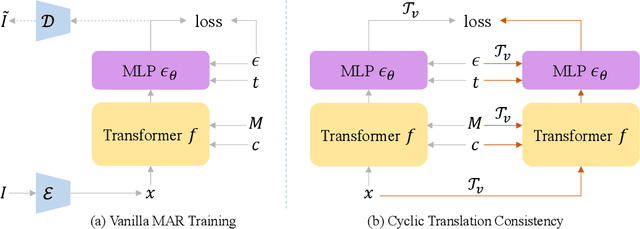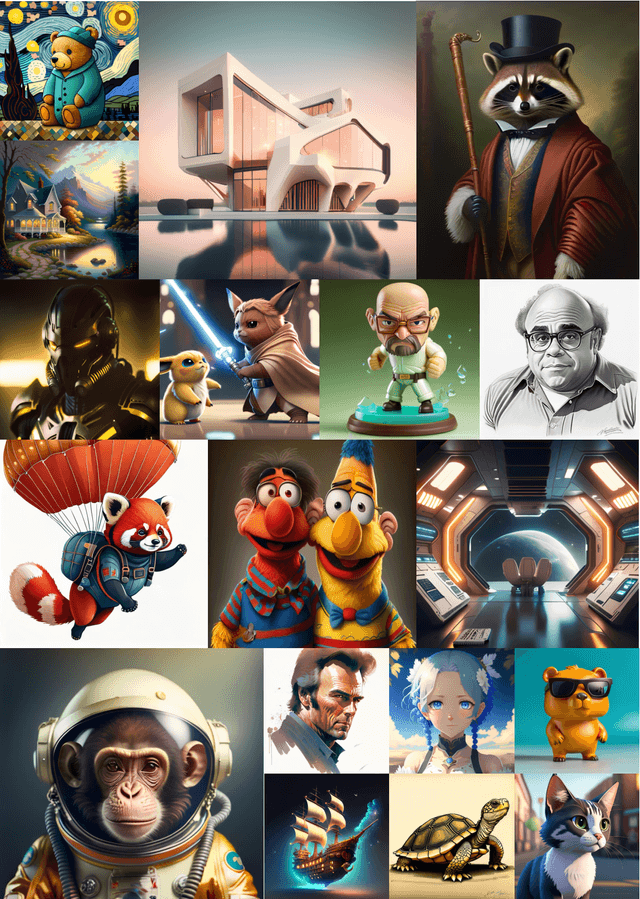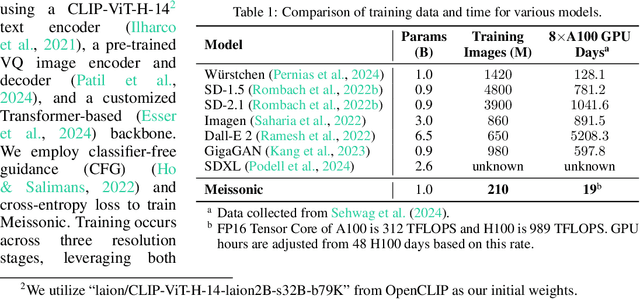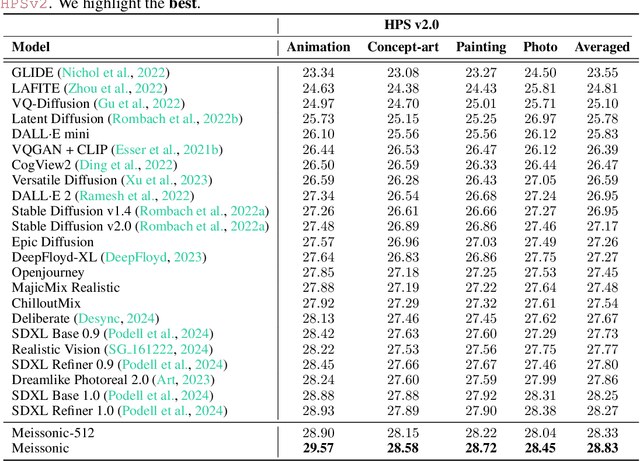Jinbin Bai
Muddit: Liberating Generation Beyond Text-to-Image with a Unified Discrete Diffusion Model
May 29, 2025Abstract:Unified generation models aim to handle diverse tasks across modalities -- such as text generation, image generation, and vision-language reasoning -- within a single architecture and decoding paradigm. Autoregressive unified models suffer from slow inference due to sequential decoding, and non-autoregressive unified models suffer from weak generalization due to limited pretrained backbones. We introduce Muddit, a unified discrete diffusion transformer that enables fast and parallel generation across both text and image modalities. Unlike prior unified diffusion models trained from scratch, Muddit integrates strong visual priors from a pretrained text-to-image backbone with a lightweight text decoder, enabling flexible and high-quality multimodal generation under a unified architecture. Empirical results show that Muddit achieves competitive or superior performance compared to significantly larger autoregressive models in both quality and efficiency. The work highlights the potential of purely discrete diffusion, when equipped with strong visual priors, as a scalable and effective backbone for unified generation.
Conditional Panoramic Image Generation via Masked Autoregressive Modeling
May 22, 2025



Abstract:Recent progress in panoramic image generation has underscored two critical limitations in existing approaches. First, most methods are built upon diffusion models, which are inherently ill-suited for equirectangular projection (ERP) panoramas due to the violation of the identically and independently distributed (i.i.d.) Gaussian noise assumption caused by their spherical mapping. Second, these methods often treat text-conditioned generation (text-to-panorama) and image-conditioned generation (panorama outpainting) as separate tasks, relying on distinct architectures and task-specific data. In this work, we propose a unified framework, Panoramic AutoRegressive model (PAR), which leverages masked autoregressive modeling to address these challenges. PAR avoids the i.i.d. assumption constraint and integrates text and image conditioning into a cohesive architecture, enabling seamless generation across tasks. To address the inherent discontinuity in existing generative models, we introduce circular padding to enhance spatial coherence and propose a consistency alignment strategy to improve generation quality. Extensive experiments demonstrate competitive performance in text-to-image generation and panorama outpainting tasks while showcasing promising scalability and generalization capabilities.
An Empirical Study of GPT-4o Image Generation Capabilities
Apr 08, 2025Abstract:The landscape of image generation has rapidly evolved, from early GAN-based approaches to diffusion models and, most recently, to unified generative architectures that seek to bridge understanding and generation tasks. Recent advances, especially the GPT-4o, have demonstrated the feasibility of high-fidelity multimodal generation, their architectural design remains mysterious and unpublished. This prompts the question of whether image and text generation have already been successfully integrated into a unified framework for those methods. In this work, we conduct an empirical study of GPT-4o's image generation capabilities, benchmarking it against leading open-source and commercial models. Our evaluation covers four main categories, including text-to-image, image-to-image, image-to-3D, and image-to-X generation, with more than 20 tasks. Our analysis highlights the strengths and limitations of GPT-4o under various settings, and situates it within the broader evolution of generative modeling. Through this investigation, we identify promising directions for future unified generative models, emphasizing the role of architectural design and data scaling.
Decouple and Track: Benchmarking and Improving Video Diffusion Transformers for Motion Transfer
Mar 21, 2025Abstract:The motion transfer task involves transferring motion from a source video to newly generated videos, requiring the model to decouple motion from appearance. Previous diffusion-based methods primarily rely on separate spatial and temporal attention mechanisms within 3D U-Net. In contrast, state-of-the-art video Diffusion Transformers (DiT) models use 3D full attention, which does not explicitly separate temporal and spatial information. Thus, the interaction between spatial and temporal dimensions makes decoupling motion and appearance more challenging for DiT models. In this paper, we propose DeT, a method that adapts DiT models to improve motion transfer ability. Our approach introduces a simple yet effective temporal kernel to smooth DiT features along the temporal dimension, facilitating the decoupling of foreground motion from background appearance. Meanwhile, the temporal kernel effectively captures temporal variations in DiT features, which are closely related to motion. Moreover, we introduce explicit supervision along dense trajectories in the latent feature space to further enhance motion consistency. Additionally, we present MTBench, a general and challenging benchmark for motion transfer. We also introduce a hybrid motion fidelity metric that considers both the global and local motion similarity. Therefore, our work provides a more comprehensive evaluation than previous works. Extensive experiments on MTBench demonstrate that DeT achieves the best trade-off between motion fidelity and edit fidelity.
Evaluating Image Caption via Cycle-consistent Text-to-Image Generation
Jan 08, 2025



Abstract:Evaluating image captions typically relies on reference captions, which are costly to obtain and exhibit significant diversity and subjectivity. While reference-free evaluation metrics have been proposed, most focus on cross-modal evaluation between captions and images. Recent research has revealed that the modality gap generally exists in the representation of contrastive learning-based multi-modal systems, undermining the reliability of cross-modality metrics like CLIPScore. In this paper, we propose CAMScore, a cyclic reference-free automatic evaluation metric for image captioning models. To circumvent the aforementioned modality gap, CAMScore utilizes a text-to-image model to generate images from captions and subsequently evaluates these generated images against the original images. Furthermore, to provide fine-grained information for a more comprehensive evaluation, we design a three-level evaluation framework for CAMScore that encompasses pixel-level, semantic-level, and objective-level perspectives. Extensive experiment results across multiple benchmark datasets show that CAMScore achieves a superior correlation with human judgments compared to existing reference-based and reference-free metrics, demonstrating the effectiveness of the framework.
HumanEdit: A High-Quality Human-Rewarded Dataset for Instruction-based Image Editing
Dec 05, 2024Abstract:We present HumanEdit, a high-quality, human-rewarded dataset specifically designed for instruction-guided image editing, enabling precise and diverse image manipulations through open-form language instructions. Previous large-scale editing datasets often incorporate minimal human feedback, leading to challenges in aligning datasets with human preferences. HumanEdit bridges this gap by employing human annotators to construct data pairs and administrators to provide feedback. With meticulously curation, HumanEdit comprises 5,751 images and requires more than 2,500 hours of human effort across four stages, ensuring both accuracy and reliability for a wide range of image editing tasks. The dataset includes six distinct types of editing instructions: Action, Add, Counting, Relation, Remove, and Replace, encompassing a broad spectrum of real-world scenarios. All images in the dataset are accompanied by masks, and for a subset of the data, we ensure that the instructions are sufficiently detailed to support mask-free editing. Furthermore, HumanEdit offers comprehensive diversity and high-resolution $1024 \times 1024$ content sourced from various domains, setting a new versatile benchmark for instructional image editing datasets. With the aim of advancing future research and establishing evaluation benchmarks in the field of image editing, we release HumanEdit at \url{https://huggingface.co/datasets/BryanW/HumanEdit}.
RelationBooth: Towards Relation-Aware Customized Object Generation
Oct 30, 2024Abstract:Customized image generation is crucial for delivering personalized content based on user-provided image prompts, aligning large-scale text-to-image diffusion models with individual needs. However, existing models often overlook the relationships between customized objects in generated images. Instead, this work addresses that gap by focusing on relation-aware customized image generation, which aims to preserve the identities from image prompts while maintaining the predicate relations described in text prompts. Specifically, we introduce RelationBooth, a framework that disentangles identity and relation learning through a well-curated dataset. Our training data consists of relation-specific images, independent object images containing identity information, and text prompts to guide relation generation. Then, we propose two key modules to tackle the two main challenges: generating accurate and natural relations, especially when significant pose adjustments are required, and avoiding object confusion in cases of overlap. First, we introduce a keypoint matching loss that effectively guides the model in adjusting object poses closely tied to their relationships. Second, we incorporate local features from the image prompts to better distinguish between objects, preventing confusion in overlapping cases. Extensive results on three benchmarks demonstrate the superiority of RelationBooth in generating precise relations while preserving object identities across a diverse set of objects and relations. The source code and trained models will be made available to the public.
MagicTailor: Component-Controllable Personalization in Text-to-Image Diffusion Models
Oct 17, 2024Abstract:Recent advancements in text-to-image (T2I) diffusion models have enabled the creation of high-quality images from text prompts, but they still struggle to generate images with precise control over specific visual concepts. Existing approaches can replicate a given concept by learning from reference images, yet they lack the flexibility for fine-grained customization of the individual component within the concept. In this paper, we introduce component-controllable personalization, a novel task that pushes the boundaries of T2I models by allowing users to reconfigure specific components when personalizing visual concepts. This task is particularly challenging due to two primary obstacles: semantic pollution, where unwanted visual elements corrupt the personalized concept, and semantic imbalance, which causes disproportionate learning of the concept and component. To overcome these challenges, we design MagicTailor, an innovative framework that leverages Dynamic Masked Degradation (DM-Deg) to dynamically perturb undesired visual semantics and Dual-Stream Balancing (DS-Bal) to establish a balanced learning paradigm for desired visual semantics. Extensive comparisons, ablations, and analyses demonstrate that MagicTailor not only excels in this challenging task but also holds significant promise for practical applications, paving the way for more nuanced and creative image generation.
Meissonic: Revitalizing Masked Generative Transformers for Efficient High-Resolution Text-to-Image Synthesis
Oct 10, 2024



Abstract:Diffusion models, such as Stable Diffusion, have made significant strides in visual generation, yet their paradigm remains fundamentally different from autoregressive language models, complicating the development of unified language-vision models. Recent efforts like LlamaGen have attempted autoregressive image generation using discrete VQVAE tokens, but the large number of tokens involved renders this approach inefficient and slow. In this work, we present Meissonic, which elevates non-autoregressive masked image modeling (MIM) text-to-image to a level comparable with state-of-the-art diffusion models like SDXL. By incorporating a comprehensive suite of architectural innovations, advanced positional encoding strategies, and optimized sampling conditions, Meissonic substantially improves MIM's performance and efficiency. Additionally, we leverage high-quality training data, integrate micro-conditions informed by human preference scores, and employ feature compression layers to further enhance image fidelity and resolution. Our model not only matches but often exceeds the performance of existing models like SDXL in generating high-quality, high-resolution images. Extensive experiments validate Meissonic's capabilities, demonstrating its potential as a new standard in text-to-image synthesis. We release a model checkpoint capable of producing $1024 \times 1024$ resolution images.
An Item is Worth a Prompt: Versatile Image Editing with Disentangled Control
Mar 07, 2024Abstract:Building on the success of text-to-image diffusion models (DPMs), image editing is an important application to enable human interaction with AI-generated content. Among various editing methods, editing within the prompt space gains more attention due to its capacity and simplicity of controlling semantics. However, since diffusion models are commonly pretrained on descriptive text captions, direct editing of words in text prompts usually leads to completely different generated images, violating the requirements for image editing. On the other hand, existing editing methods usually consider introducing spatial masks to preserve the identity of unedited regions, which are usually ignored by DPMs and therefore lead to inharmonic editing results. Targeting these two challenges, in this work, we propose to disentangle the comprehensive image-prompt interaction into several item-prompt interactions, with each item linked to a special learned prompt. The resulting framework, named D-Edit, is based on pretrained diffusion models with cross-attention layers disentangled and adopts a two-step optimization to build item-prompt associations. Versatile image editing can then be applied to specific items by manipulating the corresponding prompts. We demonstrate state-of-the-art results in four types of editing operations including image-based, text-based, mask-based editing, and item removal, covering most types of editing applications, all within a single unified framework. Notably, D-Edit is the first framework that can (1) achieve item editing through mask editing and (2) combine image and text-based editing. We demonstrate the quality and versatility of the editing results for a diverse collection of images through both qualitative and quantitative evaluations.
 Add to Chrome
Add to Chrome Add to Firefox
Add to Firefox Add to Edge
Add to Edge